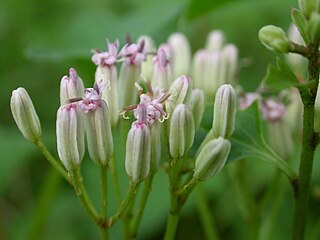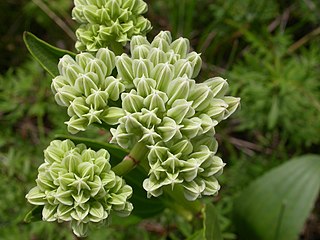
Betula alleghaniensis, the yellow birch, golden birch, or swamp birch, is a large and important lumber species of birch native to northeastern North America. Its vernacular names refer to the golden color of the tree's bark. The name Betula lutea was used expansively for this tree but has now been replaced.

Vitis aestivalis, the summer grape, or pigeon grape is a species of grape native to eastern North America from southern Ontario east to Maine, west to Oklahoma, and south to Florida and Texas. It is a vigorous vine, growing to 10 m or more high in trees. The leaves are 7–20 cm long, suborbicular, and usually a little broader than long; they are variable in shape, from unlobed to deeply three- or five-lobed, green above, and densely hairy below. The flowers are produced at every 3rd node in a dense panicle 5–15 cm long. The fruit is a small grape 5–14 mm diameter, dark purple or black in colour. It is the official state grape of Missouri. Summer grape prefers a drier upland habitat.

Rubus strigosus, the American red raspberry or American raspberry, is a species of Rubus native to much of North America. It has often been treated as a variety or subspecies of the closely related Eurasian Rubus idaeus, but currently is more commonly treated as a distinct species. Many of the commercial raspberry cultivars grown for their fruit derive from hybrids between R. strigosus and R. idaeus; see Raspberry for more details.

Arnoglossum is a North American genus of plants in the family Asteraceae, described as a genus in 1817. They have the common name Indian plantain because they resemble the unrelated common plantain.

Baptisia is a genus in the legume family, Fabaceae. They are flowering herbaceous perennial plants with pea-like flowers, followed by pods, which are sometimes inflated. They are native to woodland and grassland in eastern and southern North America. The species most commonly found in cultivation is B. australis.

Erigeron strigosus is a species of flowering plant in the family Asteraceae known by the common names prairie fleabane, common eastern fleabane, and daisy fleabane.

The genus Cacalia L. is a nomen rejiciendum under the International Code of Nomenclature for algae, fungi, and plants. The type species C. alpina L. has been transferred to Adenostyles alpina (L.) Bluff & Fingerh., and the former species of Cacalia now reside in a few different genera.

Trillium sulcatum, the furrowed wakerobin, southern red trillium or Barksdale trillium, is a perennial wildflower that blooms in April and May. It is native to the southern Appalachian Mountains and nearby areas from West Virginia to Alabama.

Arnoglossum diversifolium is a North American species of Arnoglossum and the sunflower family. It is native to the southeastern United States, the states of Florida, Georgia, and Alabama.

Arnoglossum plantagineum also known as tuberous Indian-plantain, groovestem Indian plantain or Prairie Indian plantain, is a North American species of Arnoglossum in the sunflower family. The Latin specific epithet plantagineum refers to the leaves of the plant which are similar to those of a plantain.

Solidago rugosa, commonly called the wrinkleleaf goldenrod or rough-stemmed goldenrod, is a species of flowering plant in the family Asteraceae. It is native to North America, where it is widespread across eastern and central Canada and the eastern and central United States. It is usually found in wet to mesic habitats.
Malaxis bayardii, or Bayard's adder's-mouth orchid, is a species of orchid native to northeastern North America. It is found from Massachusetts to North Carolina, with isolated populations in Ohio and Nova Scotia. There are historical reports of the plant formerly growing in Vermont and New Jersey, but it seems to have been extirpated in those two states It grows in dry, open woods and pine barrens at elevations of less than 600 m.

Bolboschoenus novae-angliae, common names New England bulrush, and Salt march bulrush is a plant species found along the Atlantic seacoast of the United States from Alabama to Maine. It grows in brackish and salt-water marshes and estuaries along the coast.
Arnoglossum album, the Bay County Indian plantain, is a rare Florida species of plants in the sunflower family, first described to modern science in 1998. It has been found only in Bay and Gulf Counties in the Florida Panhandle.
Arnoglossum floridanum, the Florida cacalia, is a Florida species of plants in the sunflower family.

Arnoglossum reniforme, the great Indian plantain, is a North American species of plants in the sunflower family. It is native to the central and east-central United States primarily in the Appalachian Mountains, the Ohio/Tennessee Valley, and the Mississippi Valley. There are additional populations in the east and farther west in Oklahoma.
Bidens eatonii is a North American species of flowering plant in the family Asteraceae. It is native to eastern Canada and the northeastern United States.
Bidens heterodoxa, the Connecticut beggarticks, is a North American species of flowering plant in the family Asteraceae. It is native to eastern Canada and the northeastern United States (Connecticut).
Hieracium robinsonii, or Robinson's hawkweed, is a North American plant species in the tribe Cichorieae within the family Asteraceae. It is native to eastern Canada and the northeastern United States. There are reports of it formerly growing in Newfoundland, but it does not appear to grow there now.

Carex bebbii, Bebb's sedge, is a species of sedge native to the northern United States and Canada. Carex bebbii grows in a variety of wetland habitats such as lakeshores, streambanks, ditches, meadows, swamps, and seeps. It forms dense tufts with culms up to 90 centimeters tall.













